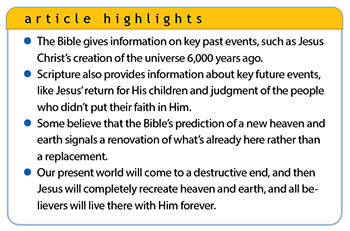 In the beginning about 6,000 years ago, Jesus Christ created the heavens and the earth out of nothing, or ex nihilo, which I discussed in a previous article.1 The Bible not only gives us information about key events of the past such as the creation week but also tells us about key events of the future.
In the beginning about 6,000 years ago, Jesus Christ created the heavens and the earth out of nothing, or ex nihilo, which I discussed in a previous article.1 The Bible not only gives us information about key events of the past such as the creation week but also tells us about key events of the future.
In the end times, Jesus Christ will return for His followers and judge the world that rejected His salvation. The present earth will then be destroyed by fire, and God will create a new heavens and earth. The new heavens and new earth are the final phase of God’s prophetic program and will be the eternal home of Christ’s followers.
Fiery Destruction of the Present World
While many Christians debate the details of eschatology, the Bible is quite clear that the present world will be destroyed. Peter said, “But the heavens and the earth which are now preserved by the same word, are reserved for fire until the day of judgment and perdition of ungodly men” (2 Peter 3:7), and “the heavens will pass away with a great noise, and the elements will melt with fervent heat; both the earth and the works that are in it will be burned up” (2 Peter 3:10).
Psalm 102:25-26 connects this end-time destruction to the original creation.
Of old You laid the foundation of the earth, and the heavens are the work of Your hands. They will perish, but You will endure; Yes, they will all grow old like a garment; Like a cloak You will change them, and they will be changed.
New Creation or Renovation
According to Revelation 21:1, after the final resurrection, there will be a new heaven and new earth: “Now I saw a new heaven and a new earth, for the first heaven and the first earth had passed away. Also there was no more sea.” Peter mentions this new heaven and new earth as well. “Nevertheless we, according to His promise, look for new heavens and a new earth in which righteousness dwells” (2 Peter 3:13). Isaiah 65:17 says, “For behold, I create new heavens and a new earth; and the former shall not be remembered or come to mind.”
The fact that there will be a new creation seems to be plainly stated in the Scriptures, but one issue that’s been debated about the coming new heaven and new earth is how new it will really be. In other words, will it be a remodeling operation (renovation) or a brand-new creation of the current world—something like Earth 2.0? If it is a re-creation, the present earth would be utterly destroyed and replaced by a totally new heaven and earth.
The renovation perspective was promoted and best described by Christian writer Randy Alcorn in his widely popular book Heaven.2 It’s noteworthy that Alcorn is a young earth creationist, so we can’t really say that his idea was influenced by an old earth perspective.3 Alcorn advocates and explains the renovation view as follows:
Romans 8:19-23 inseparably links the destinies of mankind and Earth. As such, the earth will be raised to new life in the same way our bodies will be raised to new life….The perfection of creation once lost will be fully regained, and then some….It will be as if an artist wiped away the old paint, stained and cracking, and started a new and better painting, but using the same images on the same canvas….The cleansing with fire will be more thorough than the Flood in that it will permanently eliminate sin. But just as God’s judgment by water didn’t make the earth permanently uninhabitable, neither will God’s judgment by fire.2
Biblical Evidence for a Re-Creation
 While the concept of renovation or restoration of the present earth is an interesting view, a number of biblical passages seems to clearly tell a different story. They support the total destruction of the present heaven and earth and replacement by a new heaven and earth.
While the concept of renovation or restoration of the present earth is an interesting view, a number of biblical passages seems to clearly tell a different story. They support the total destruction of the present heaven and earth and replacement by a new heaven and earth.
One of these Scriptures is a powerful declaration by Christ, who compared the eternal nature of His Word to the temporal nature of the current world. Matthew 24:35 says, “Heaven and earth will pass away, but My words will by no means pass away.” It’s noteworthy that Christ uttered these words immediately after saying, “Now learn this parable from the fig tree,” in which He cursed a fig tree, and it withered and died (Matthew 24:32-34).
A passage from Isaiah likens the end of the world to the withering and death of a plant or tree. “All the host of heaven shall be dissolved, and the heavens shall be rolled up like a scroll; all their host shall fall down as the leaf falls from the vine, and as fruit falling from a fig tree” (Isaiah 34:4). Isaiah 51:6 also includes this withering theme for the end of the world:
Lift up your eyes to the heavens, and look on the earth beneath. For the heavens will vanish away like smoke, the earth will grow old like a garment, and those who dwell in it will die in like manner; but My salvation will be forever, and My righteousness will not be abolished.
And Peter’s description of the end of the world tells us exactly how this withering will take place.
The heavens will pass away with a great noise, and the elements will melt with fervent heat; both the earth and the works that are in it will be burned up….The heavens will be dissolved, being on fire, and the elements will melt with fervent heat. (2 Peter 3:10, 12)
John adds additional details in his vision in Revelation.
Then I saw a great white throne and Him who sat on it, from whose face the earth and the heaven fled away. And there was found no place for them. (Revelation 20:11)
Now I saw a new heaven and a new earth, for the first heaven and the first earth had passed away. Also, there was no more sea. (Revelation 21:1)
It’s very difficult to reconcile these passages with the notion of a remodel job or renovation for the present creation. These verses seem to clearly teach a total destruction of the present world followed by a complete re-creation, or new creation. The Bible couldn’t have made it any clearer that this present world will be destroyed by fire and utterly pass away.
In addition to the clear statements in these Bible verses in the English translation, there’s one additional textual point that favors the destruction and re-creation view. In the Greek text of Revelation 21:1 above, we see the phrase “passed away,” which is the verb aperchomai. This verb is modified in the aorist tense (apelthon) to indicate that it’s a completed action in the fulfillment of this prophetic vision. This is the same aorist verb used in Revelation 21:4, which says regarding the redeemed saints in heaven, “And God will wipe away every tear from their eyes; there shall be no more death, nor sorrow, nor crying. There shall be no more pain, for the former things have passed away.”
The meaning of “passed away” in Revelation 21:4 is unambiguous, and no one would argue that the tears, mourning, crying, or pain are only renovated or remodeled. Everyone would agree that this means these things are eliminated forever. Since this same Greek word appears just three verses apart in Revelation 21 in the same end-time context, it’s logical to assume that it carries the same meaning in verse one that it does in verse four. This further supports the idea that the present heaven and earth will be destroyed and completely removed to make way for a new heaven and new earth.
Conclusion
The original creation was created very good, as proclaimed by God when He was done making the man and woman on the sixth day (Genesis 1:31). However, Adam plunged the human race into a world of sin and misery, bringing a curse upon the whole of creation.
According to many prophecies in the Scriptures, Jesus Christ came to redeem mankind through His death on the cross and resurrection from the dead. And this same Jesus, “through whom also He [God] made the worlds” (Hebrews 1:2), will come again and bring an end to both sin and this fallen world—bringing in a new one.
References
- Tomkins, J. P. 2023. Creation Ex Nihilo Through Jesus Christ. Acts & Facts. 52 (1): 14-16.
- Alcorn, R. 2004. Heaven. Carol Stream, IL: Tyndale Momentum.
- Alcorn, R. What Is Your Position on the Age of the Earth? Eternal Perspectives Ministries. Posted on emp.org February 15, 2010, accessed January 5, 2023.
* Dr. Tomkins is Research Scientist at the Institute for Creation Research and earned his Ph.D. in genetics from Clemson University.













